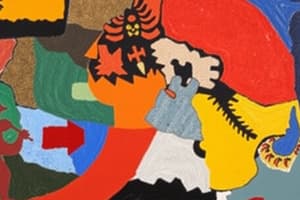Podcast
Questions and Answers
Why did the Natives feel compelled to sign treaties despite potential risks?
Why did the Natives feel compelled to sign treaties despite potential risks?
- They had no other negotiating options available
- The government warned that refusal could lead to losing everything (correct)
- They were forced by military presence
- They had been promised land outside of reserves
What was one of the core reasons the treaties were considered sacred by aboriginal peoples?
What was one of the core reasons the treaties were considered sacred by aboriginal peoples?
- They involved legal representatives from both sides
- They were based on people's honor through oral traditions (correct)
- They were documented with detailed written contracts
- They were celebrated with ceremonies in public
What significant consequence did signing Treaty No. 6 have on the aboriginal population?
What significant consequence did signing Treaty No. 6 have on the aboriginal population?
- Richer agricultural land
- Mass loss of land and resources like bison (correct)
- Stronger political power within the government
- Increased access to educational resources
Which of the following rights were Natives promised in exchange for signing treaties?
Which of the following rights were Natives promised in exchange for signing treaties?
What was one key element of the Immigration Act?
What was one key element of the Immigration Act?
What are the two primary conditions set by the government for homesteading?
What are the two primary conditions set by the government for homesteading?
Why was the Pacific Scandal significant in Canadian history?
Why was the Pacific Scandal significant in Canadian history?
What unfair condition did the Indian Act impose on Native women who married non-Natives?
What unfair condition did the Indian Act impose on Native women who married non-Natives?
What were the three difficulties associated with building the railway?
What were the three difficulties associated with building the railway?
Which of the following were injustices faced by Chinese workers during the railway construction?
Which of the following were injustices faced by Chinese workers during the railway construction?
What economic program was known for promoting Canadian industry?
What economic program was known for promoting Canadian industry?
Who was awarded the railway contract and what did the government offer them?
Who was awarded the railway contract and what did the government offer them?
What was a primary cause of the Northwest Rebellion?
What was a primary cause of the Northwest Rebellion?
What tactic did the natives employ to achieve victories against settlers?
What tactic did the natives employ to achieve victories against settlers?
Why did the natives lose the Battle of Batoche?
Why did the natives lose the Battle of Batoche?
What was the impact of Riel's conviction on societal tensions?
What was the impact of Riel's conviction on societal tensions?
What happened to Gabriel Dumont and Louis Riel after the rebellion?
What happened to Gabriel Dumont and Louis Riel after the rebellion?
What was a consequence of the North American Free Trade Agreement (NAFTA) for Canada?
What was a consequence of the North American Free Trade Agreement (NAFTA) for Canada?
Flashcards
Sacred Treaties
Sacred Treaties
Agreements that were based on the honor of Aboriginal peoples.
Reasons for Treaty Signing
Reasons for Treaty Signing
Pressure from officials and false promises of the government led Natives to sign treaties.
Promises in Treaties
Promises in Treaties
Natives were promised land rights, money, agricultural tools, and schools.
Consequences of Treaty No. 6
Consequences of Treaty No. 6
Signup and view all the flashcards
Unfair Indian Act
Unfair Indian Act
Signup and view all the flashcards
Immigration Quarantine
Immigration Quarantine
Signup and view all the flashcards
Homesteading Requirements
Homesteading Requirements
Signup and view all the flashcards
Pacific Scandal
Pacific Scandal
Signup and view all the flashcards
Challenges of Railway Construction
Challenges of Railway Construction
Signup and view all the flashcards
Injustices to Chinese Workers
Injustices to Chinese Workers
Signup and view all the flashcards
National Policy
National Policy
Signup and view all the flashcards
Canadian Pacific Railway Contract
Canadian Pacific Railway Contract
Signup and view all the flashcards
Cause of Northwest Rebellion
Cause of Northwest Rebellion
Signup and view all the flashcards
Guerrilla Tactics
Guerrilla Tactics
Signup and view all the flashcards
Battle of Batoche Loss
Battle of Batoche Loss
Signup and view all the flashcards
Consequences for Riel and Chiefs
Consequences for Riel and Chiefs
Signup and view all the flashcards
Anglophone vs Francophone Tensions
Anglophone vs Francophone Tensions
Signup and view all the flashcards
NAFTA Impact
NAFTA Impact
Signup and view all the flashcards
Study Notes
Indigenous Treatment
- Treaties were considered sacred due to the principle of honour, even if oral.
- Indigenous peoples signed treaties due to government threats (loss of possessions) and promises.
- Promises included reserve land rights, hunting/fishing rights, annual payments, agricultural tools/techniques, and reserve schools.
- Treaty No. 6 consequences included massive land loss, bison extinction, and starvation.
- The Indian Act was unfair due to voting/alcohol restrictions, women's status discrepancies (marriage), government timber authorization on reserves, unequal legal proceedings, and voting restrictions dependent on renunciation of Indigenous status.
Colonization
- Passengers arriving in Canada were quarantined to prevent contagious diseases.
- The Immigration Act aimed to control contagious disease entry and limit immigrant numbers per ship.
- Rupert's Land was governed by the Power Lands Act.
- The Prairies were divided into cantons, approximately 10 km² each.
- Homesteading involved land allocation for farming. A house and functioning farm were required within 3 years; otherwise, the land returned to government ownership.
Transcontinental Railway
- Pacific Scandal: John A. Macdonald's campaign funding ($350,000) from a railroad contract recipient appeared like a bribery scheme.
- Railway construction difficulties included funding issues, mountainous terrain, and swampy areas.
- Chinese railway workers faced dangerous conditions, inadequate food and shelter, poor medical care, lower wages, repatriation denial, and family immigration restrictions.
- The National Policy aimed to boost Canadian industry. Measures included higher tariffs on foreign goods and lower tariffs on imported raw materials.
- Canadian Pacific Railway (CPR) received a significant land grant, financial support, and a non-competition guarantee for the railway contract.
Northwest Rebellion
- The Northwest Rebellion stemmed from Métis land anxieties due to settler expansion into Saskatchewan, after previous displacement.
- Indigenous groups used guerrilla warfare tactics (surprise attacks).
- The loss of the Battle of Batoche was caused by leadership disagreements: Dumont (surprise) versus Riel (negotiation). Inadequate defense strategy led to defeat.
- Chiefs Poundmaker and Big Bear, and Louis Riel, faced imprisonment or execution.
- The Riel conviction created Anglophone-Francophone tensions because British-origin groups desired punishment, while French-speaking groups saw him as a Métis defender.
Miscellaneous
- Gabriel Dumont was war lieutenant in Louis Riel's provisional government.
- The North American Free Trade Agreement (NAFTA) permitted duty-free entry of goods from Mexico and the USA.
- After the Pacific Scandal, John A. Macdonald gave way to Alexander Mackenzie, Canada's 2nd Prime Minister.
- A bribe may be considered a "pot de vin."
- Guerrilla tactics are characterized by surprise attacks and harassment of the enemy.
Studying That Suits You
Use AI to generate personalized quizzes and flashcards to suit your learning preferences.




